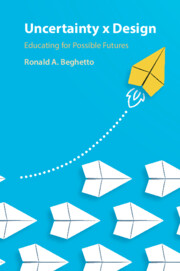53 results
Contents
-
- Book:
- Uncertainty x Design
- Published online:
- 19 October 2023
- Print publication:
- 02 November 2023, pp vii-viii
-
- Chapter
- Export citation
Chapter 2 - Designing for Likely Futures
- from Part I - Approaching Uncertain Futures
-
- Book:
- Uncertainty x Design
- Published online:
- 19 October 2023
- Print publication:
- 02 November 2023, pp 19-39
-
- Chapter
- Export citation
Chapter 4 - Start with Uncertainty
- from Part I - Approaching Uncertain Futures
-
- Book:
- Uncertainty x Design
- Published online:
- 19 October 2023
- Print publication:
- 02 November 2023, pp 54-74
-
- Chapter
- Export citation
Dedication
-
- Book:
- Uncertainty x Design
- Published online:
- 19 October 2023
- Print publication:
- 02 November 2023, pp v-vi
-
- Chapter
- Export citation
Chapter 7 - To Act or Not to Act
- from Part II - Designing for Uncertain Futures
-
- Book:
- Uncertainty x Design
- Published online:
- 19 October 2023
- Print publication:
- 02 November 2023, pp 115-137
-
- Chapter
- Export citation
Acknowledgments
-
- Book:
- Uncertainty x Design
- Published online:
- 19 October 2023
- Print publication:
- 02 November 2023, pp xvi-xvi
-
- Chapter
- Export citation
Chapter 5 - Structuring Uncertainty for Learning
- from Part II - Designing for Uncertain Futures
-
- Book:
- Uncertainty x Design
- Published online:
- 19 October 2023
- Print publication:
- 02 November 2023, pp 77-95
-
- Chapter
- Export citation
References
-
- Book:
- Uncertainty x Design
- Published online:
- 19 October 2023
- Print publication:
- 02 November 2023, pp 162-172
-
- Chapter
- Export citation
Preface
-
- Book:
- Uncertainty x Design
- Published online:
- 19 October 2023
- Print publication:
- 02 November 2023, pp xi-xv
-
- Chapter
- Export citation
Chapter 8 - Making Principled Contributions
- from Part II - Designing for Uncertain Futures
-
- Book:
- Uncertainty x Design
- Published online:
- 19 October 2023
- Print publication:
- 02 November 2023, pp 138-159
-
- Chapter
- Export citation
Chapter 6 - Seeing the Possible in Uncertainty
- from Part II - Designing for Uncertain Futures
-
- Book:
- Uncertainty x Design
- Published online:
- 19 October 2023
- Print publication:
- 02 November 2023, pp 96-114
-
- Chapter
- Export citation
Part II - Designing for Uncertain Futures
-
- Book:
- Uncertainty x Design
- Published online:
- 19 October 2023
- Print publication:
- 02 November 2023, pp 75-159
-
- Chapter
- Export citation
Chapter 1 - What Do We Owe Students?
- from Part I - Approaching Uncertain Futures
-
- Book:
- Uncertainty x Design
- Published online:
- 19 October 2023
- Print publication:
- 02 November 2023, pp 3-18
-
- Chapter
- Export citation
Part I - Approaching Uncertain Futures
-
- Book:
- Uncertainty x Design
- Published online:
- 19 October 2023
- Print publication:
- 02 November 2023, pp 1-74
-
- Chapter
- Export citation
Chapter 3 - Designing for Uncertain Futures
- from Part I - Approaching Uncertain Futures
-
- Book:
- Uncertainty x Design
- Published online:
- 19 October 2023
- Print publication:
- 02 November 2023, pp 40-53
-
- Chapter
- Export citation
Index
-
- Book:
- Uncertainty x Design
- Published online:
- 19 October 2023
- Print publication:
- 02 November 2023, pp 173-174
-
- Chapter
- Export citation
Copyright page
-
- Book:
- Uncertainty x Design
- Published online:
- 19 October 2023
- Print publication:
- 02 November 2023, pp iv-iv
-
- Chapter
- Export citation
Figures
-
- Book:
- Uncertainty x Design
- Published online:
- 19 October 2023
- Print publication:
- 02 November 2023, pp ix-x
-
- Chapter
- Export citation
Avanti - From What Is to What Could Be
-
- Book:
- Uncertainty x Design
- Published online:
- 19 October 2023
- Print publication:
- 02 November 2023, pp 160-161
-
- Chapter
- Export citation

Uncertainty x Design
- Educating for Possible Futures
-
- Published online:
- 19 October 2023
- Print publication:
- 02 November 2023

